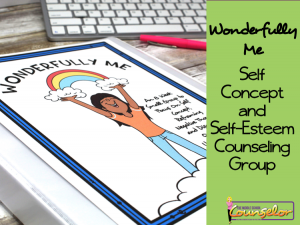Helping a young person become who they want to be takes time and encouragement. It takes paying attention to what sparks a passion. . We listen, we encourage, and we provide the opportunity to uncover each young person’s unique interests.
So many counselors tell me that they are a bit intimidated about running a group, or that they feel when they tried in the past, their groups were unsuccessful. Truth be told, it really isn’t difficult, but there are a few basic tips to help make it run smoothly, go well, and be fun.
1. Be Intentional. This is perhaps the key. Know what skills you want your kids to have before beginning your group. It’s the Sean Covey model of “Begin with the end in mind.” So true. You need to know where you want to go so you can map out how you’re going to get there. A good curriculum, will help you with this if you don’t have that much time to do all the planning, or you’re not sure the best way to map out your path.
2. Find a Space. My new office is so small–like storage closet size. I can’t get 4 girls in comfortably, so I had to search around and find a space. When looking for a room use these guidelines:
- Room for games where kids need to get up and walk around
- Space for smaller sub groups to work
- Accessible to all members
- Table space is large enough for crafts, games, and lunches
- Close access to restrooms
- Area is free from hazards
- There is a spot for trash, recyclables, and clean up stuff
3. Have Supplies Ready. Just like any lesson plan, you can’t just open a book seconds before the class shows up and expect to be 100% ready to go. Preview what you are doing ahead of time and have things ready. This is especially true if your groups are during lunch. I tend to have my basic supplies always ready and within reach. My colored pencils, markers, and pens/pencils are in tins that sit in the center of my table and I always have a stack of paper sitting underneath because you never know when you’ll need it. I also find it handy to put my curriculum in binders and then have plastic folders for each session with usable materials of that week’s lesson. If you need to go into another room, get a small bin to hold all you materials as you travel to a different room. I find if I don’t do this I’m running back to my room for glue sticks, or a stapler, or pencil sharpener at least 3 times during a meeting time. As you collect materials for your counseling groups here’s a list of some basics that should help you always be ready.
- Pens, pencils, markers
- Pencil sharpeners ( I just keep a few manual ones around)
- Blank copy paper
- Scissors (8 is a good number)
- Scotch tape
- Stapler (1 is good, 2 is better)
- Dice (I like the large foam dice you can get in the dollar stores)
- Small ball
- Tongue Depressors (these are great for writing down icebreaker questions)
- Glue sticks (3-4 typically are enough)
- Double sided tape (I use this but don’t let the kids use it. Mostly to take paper dice or hand things around the room)
- Tissues
- Napkins or paper towels
- String (I never expect to use string, but am surprised I find myself grabbing it a lot)
- Lysol wipes–especially if you meet at lunch
- StarBound is really great for middle schoolers and upper elementary. It’s focus is empowerment and working in teams and leadership development. It’s perfect for strong girls who are seen as “bossy”, “opinionated” or “difficult” and gives them opportunity to take their strengths and work with others.
- Wonderfully Me is also great for middle schoolers and upper elementary. I’m using this with 4th graders right now. It’s perfect for those kids that feel like no one likes them and that they have no friends. Most of my kids in this group are pretty quiet, although I have 2 that can really speak their minds! The focus is on looking at their inner strengths, changing negative thoughts into positive ones, and learning strategies to reduce stress and anxiety. It also uses mindfulness and CBT skills.
- Unique You-nicorns is for primary elementary girls. It focuses on what makes them unique, healthy friendships and communication skills. It’s perfect for those wee loves that struggle with friendships and get pushed around a lot by their “friends”.
No matter, what curriculum you use, just make sure it leads back to #1–Be Intentional. You can’t help make the changes needed, if you never identify the needs or you don’t teach skills that are solution focused.













